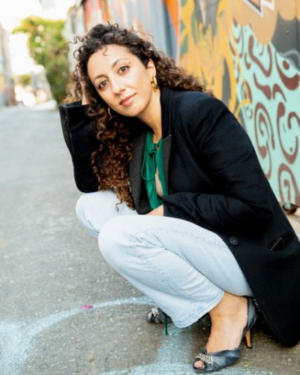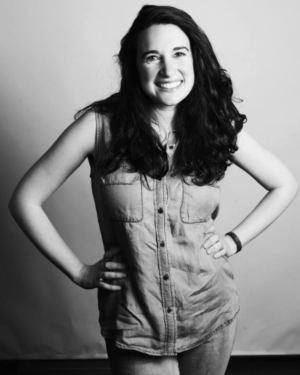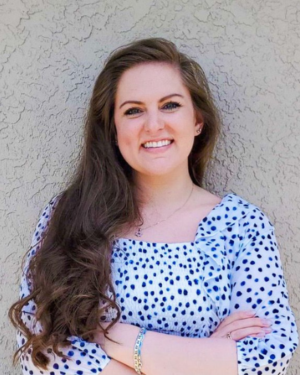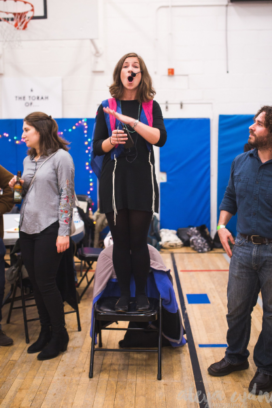American View
Being Jewish
Envisioning the Rabbinate Through a Different Lens

Tarlan Rabizadeh had wanted to become a rabbi ever since she was a teenager, but only much later overcame the objections of her parents, Jewish immigrants from Iran, and the expectations of her traditional Persian community in Los Angeles.
Inspired by Rabbi Sharon Brous, then a teacher at the Milken Community School, the Jewish day school Rabizadeh attended, she describes the rabbinate as a “calling” that she finally fulfilled after working as an interior designer and Jewish educator. She was ordained at the Reform movement’s Hebrew Union College-Jewish Institute of Religion in Manhattan in 2018 and is now director of student life at UCLA’s Hillel.
The 36-year-old Rabizadeh hopes to use her expertise and background to bridge the Ashkenazi and non-Ashkenazi worlds. For her, “being a rabbi is really about being a translator between the two communities,” she said. It’s about “explaining and helping integrate two different cultures, both of which happen to be Jewish” but which have different perspectives “on how some of those values should be carried out.”
Rabizadeh is not alone in the circuitous path she took to the rabbinate.
Before Yael Werber decided to apply to rabbinical school, she had worked on Jewish-owned farms and in restaurants; lived in a cabin with no running water, electricity or plumbing; wrote a children’s book, Spring for Sophie; co-owned a company that sold cloth menstrual pads; went to herbalism school; briefly tried nursing school; earned a degree in speech therapy from Boston University; and taught preschool in Manhattan.

Though she was raised with a strong Jewish identity in a Conservative home in Boston, it took an “aha!” moment for Werber, now 35, to veer from the female caregiver roles she grew up with in her family and community—like teacher and nurse—to a rabbinic path. But when her supervisor in nursing school berated her, she said, for spending too much time talking to a dying 90-year-old man and his family, she realized that the care she wanted to give required a different focus.
In May, she will be ordained at the pluralistic Hebrew College in Newton Centre, Mass. “Being a rabbi was that thing I was seeking—walking with people in hard times and low places as well as in joyous times,” she said.
The stories of these women mirror those of a new generation of female rabbis being ordained by mainstream liberal Jewish seminaries across the country. Striking in their diverse backgrounds, approaches and visions for the future, current students and newly minted rabbis include Jews by choice, Jews of color and Jews who identify as LBGTQ as well as those who grew up in traditional, liberal, secular and interfaith homes. They cross denominational lines in their choice of seminaries and opt for careers ranging from congregational pulpits to Hillel, from chaplaincy to Jewish education and nonprofit work. Some are choosing new and experimental organizations; some are even creating their own startups.
Gender parity has largely evened out between male- and female-identified students at most of the seminaries, though statistics around career choices vary. At Hebrew College, fewer than 50 percent of alumni are choosing congregational work these days, down from 70 percent 18 years ago, when the college’s rabbinical program was founded. Among newly ordained Reform rabbis, the number seeking pulpit positions is 70 to 80 percent, but even that represents a decline from past years. Officials in the Conservative movement say about half of their rabbis currently hold pulpit positions.
WATCH NOW: CELEBRATING 50 YEARS OF FEMALE RABBIS
A virtual event featuring Rabbis Sally Priesand, Sandy Eisenberg Sasso, Amy Eilberg and Sara Hurwitz, all of whom made history by becoming the first ordained rabbis in their respective denominations.
“Jews are entering Jewish life through so many kinds of doorways—the arts, yoga, illness, education—and we need rabbis in all those door-ways,” said Rabbi Sharon Cohen Anisfeld, president of Hebrew College and former dean of its rabbinical school.
Werber said she often speaks to congregants at the three synagogues at which she has served as an intern, most recently at Congregation Beit Simchat Torah in Manhattan, about “the winding path to figuring out who we are.“
My growth has not been linear,” she said. “Many people are able to relate to that feeling of not knowing exactly where they are in life, or their purpose, or their very next step. They can feel comforted when a rabbi acknowledges that fear or anxiety. Being unsure of what comes next is a normal part of the human process, especially in pandemic times.”

Kanaan Goldstein hopes to become a military chaplain and help erase the stigma of mental health issues in the military. The 30-year-old, second-year student at the Reconstructionist Rabbinical College in suburban Philadelphia was raised in a Reform home in Norman, Okla. She joined the Navy at 17, searching for independence and control after her parents had divorced four years earlier. Disciplined for an infraction of military rules, she spoke to a rabbi-chaplain for a mental health check-in. “That changed my life,” she said.
When she was stationed on the warship U.S.S. Wasp in Norfolk, Va.—“They put a nice Jewish girl on the Wasp,” she joked—she took leadership roles in both Jewish and military spheres, conducting services on board and attaining the rank of Petty Officer Second Class. In Norfolk, she sought out the local synagogue, Ohef Sholom Temple, where two female rabbis became her mentors: Rosalin Mandelberg, senior rabbi of the congregation, and a member, Connie Golden.
Issues surrounding interfaith relationships have been and might continue to be an obstacle for Goldstein, whose partner is not Jewish. She chose to study at RRC because that is the only rabbinical seminary among the mainstream denominations that accepts and ordains students in interfaith relationships.
Goldstein remains intent on achieving her goal to create space for leaders who are in interfaith relationships in the Jewish community. “The two circles of my life”—Judaism and a career in the military—“are distinct bubbles, yet so similar to each other,” she said. “They are both rooted in tradition, routine and history and focus on community.” The rabbinate, she said, will further equip her to bridge her two worlds.
READ MORE: Transforming the Rabbinate Over 50 Years
The job market is good for rabbinical students seeking pulpits these days. While some congregations are shrinking and merging, others are booming and new ones are forming—all of which translates into an “explosion” of requests for rabbis today across denominations, said Rabbi Dvora Weisberg, director of the HUC-JIR rabbinical school.
Some of the demand is due to retirements and resignations during Covid or to congregations that delayed hiring, movement officials say.
Rabbi Jan Uhrbach, interim dean of the rabbinical and cantorial schools at the Jewish Theological Seminary in New York City, speculates that next-generation rabbis—women and men—who have grown up in a post-9/11 environment of fear, uncertainty, divisiveness and xenophobia, are looking for positions in communities “with a strong culture of kindness, equity and social justice.” At the same time, they are seeking boundaries between work and personal life to make their rabbinates manageable and sustainable.
Aspiring and new rabbis are also entering Jewish life at a time of change. “Students in the rising generation know they’re going to have to build the Jewish future in entrepreneurial ways because of the massive changes in Jewish communal life in the past 15 years,” Rabbi Deborah Waxman, president and CEO of Reconstructing Judaism, said, citing declining membership in congregations as one example of the change.
“It’s painful and confusing, and there’s also a lot of opportunity,” Waxman said. “Our students are not mourning what once was. They’re using ancient wisdom to build a Jewish future.”

Rabbi Lauren Henderson, a JTS graduate and rabbi at Or Hadash congregation in the Atlanta suburb of Sandy Springs, Ga., envisions creating a “haimish community with a homey feeling where it’s profoundly intergenerational and the elders know the b’nai mitzvah students and everyone pitches in to make food for kiddush.” One of her models is Temple B’nai Israel, the only synagogue in Spartanburg, S.C., which her interfaith family joined when she was 8 years old.
At the same time, the 34-year-old rabbi, who started her new post at the 320-family congregation in July 2020, is “exploring what 21st century Judaism looks like,” including more mindfulness during prayer. Given her family heritage, Henderson is also sensitive to issues of interfaith marriage and is studying halachic parameters that might allow Conservative rabbis to take part in wedding ceremonies where one partner is not Jewish.
For Henderson, it was not a rabbi but a Messianic Jew who compelled her to learn more about her Jewish roots. As an undergraduate at Rice University, a friend invited her to a meeting of Campus Crusade for Christ, where the speaker urged attendees to spread the gospel in order to be true friends to one another. She left that evening angry yet determined to deepen her Jewish knowledge, and she promptly joined Hillel. She began her rabbinic studies at the Conservative movement’s Ziegler School at the American Jewish University in Los Angeles and later transferred to JTS, where she was ordained in 2016.
Her experiences have shown her that “we are no longer rabbis with all the answers,” said Henderson. “I’m continually mesmerized by the richness of Jewish tradition, its boldness, how radical it can be, and its resilience. My role is to be a fellow learner alongside others, to be a curator of the evolution of Torah, and to bring my community into that larger conversation.”
Then and Now: The ‘Four Firsts’ ordained in their respective denominations weigh challenges to the Jewish community
For the past few months, her community has been taking part in a project called Toratah, or the Regendered Bible, in which the artist Yael Kanarek has switched the genders of every character in the Torah from male to female or female to male—including God. “We’re watching,” Henderson said, “as this new lens on Torah is being created before our eyes, in real time, and discussing each week how we understand Torah’s evolution in the 21st century.”
Despite the growing diversity, some populations remain underrepresented in the new generation of liberal rabbis. “America allowed me to become a rabbi,” Rabizadeh, the UCLA Hillel rabbi, said. But she also struggles with being a “token of diversity,” she said, noting that she was the only non-Ashkenazi in rabbinical school at HUC in Manhattan and at her former position at the eclectic congregation The Kitchen in San Francisco, part of the Jewish Emergent Network of collaborating innovative communities where she was a rabbinic fellow.
“People have asked me when I converted,” she said. Her master’s thesis at HUC involved writing a trilingual Progressive Persian Haggadah. In the future, she hopes to create a synagogue or a school to share the richness of Persian and other non-Ashkenazi traditions, or write books that are not “flat and one-sided” portrayals of what Jews look like.
UCLA Hillel’s large Persian population allows Rabizadeh to guide students who remind her of herself. “The reason Moses could do the job of leading the Jewish people out of Egypt is that he was born Jewish, but he lived in the palace,” she said. “He was both an Egyptian and a Hebrew. I feel like that, too.”
She also has faith in the power of the rabbinate. “Rabbis are more than just spiritual guides,” she said. “We’re judges and lawyers, we’re counselors and therapists. We’re paid to think and observe the world.”
In Israel, Breaking Barriers in the Orthodox World
Rahel Musleah leads virtual tours of Jewish India and other cultural events and hopes to lead her first post-pandemic, in-person tour in November 2022 (explorejewishindia.com).










 Facebook
Facebook Instagram
Instagram Twitter
Twitter
Brian Shamash says
Inspirational!!! Thank you!